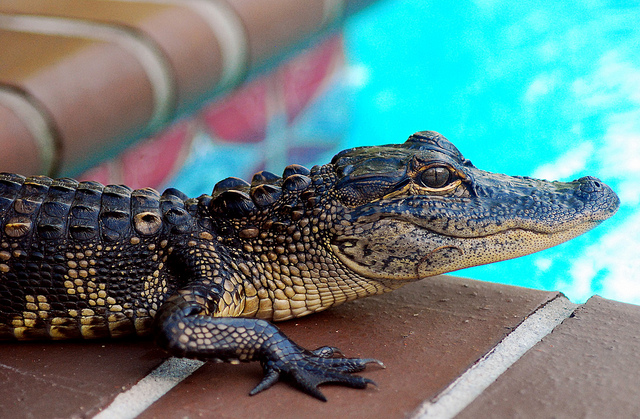
A small alligator hanging out poolside at a Florida home. Photo © Trish Hartmann, licensed Creative Commons Attribution.
Alligators were first listed as an endangered species in 1967, their numbers threatened by hunting and habitat loss. Then the American alligator was removed from the endangered species list in 1987 after the U.S. Fish and Wildlife Service pronounced a complete recovery of the species. Conservative estimates put the population at around a million just in Florida. Because they can tolerate brackish water as well as freshwater, they can be found in rivers, swamps, bogs, lakes, ponds, creeks, canals, swimming pools, and lots of Florida golf courses.The American alligator is the largest reptile in North America. They can live 35–50 years in the wild, 60–80 years in captivity. The average adult male is 13 feet in length, although they can grow up to 18 feet long. Bulls are generally larger than females, weighing 450–600 pounds.
They’re everywhere in Florida, and they eat just about anything. Usually that means lizards, fish, snakes, turtles, even little gators.
Florida residents have learned to be blasé about gators. They’re an everyday part of living in this subtropical climate. In the past decade, there have been dozens and dozens of reported gator attacks on humans, though only one fatality.
The problems are not just a function of large numbers. People feed the gators and thus the alligators have gotten chummy and less fearful of humans. So new policies were put in place. In many spots along the Gulf Coast, if gators get large (over eight feet) they are taken away and “processed” (not a good euphemism). Smaller ones get relocated.
Alligators are cold-blooded. They don’t need to eat as much or as often as their warm-blooded counterparts. In fact, they can’t eat unless their internal body temperature is 90 degrees. Thus, they don’t eat all winter, and in the spring they can be seen basking on the banks in a sunny spot. They’re hungry in April and May, a good time to steer clear. In the summer, the females lay their eggs (up to 70) in a nest and cover them over, then the eggs incubate for 65 days. The mom stays close, carrying the freshly hatched babies to the water. Even after they’re swimming around, mama is protective for up to the first two years.
Things to keep in mind, for your safety and the safety of others:
Excerpted from the Second Edition of Moon Tampa & St. Petersburg.